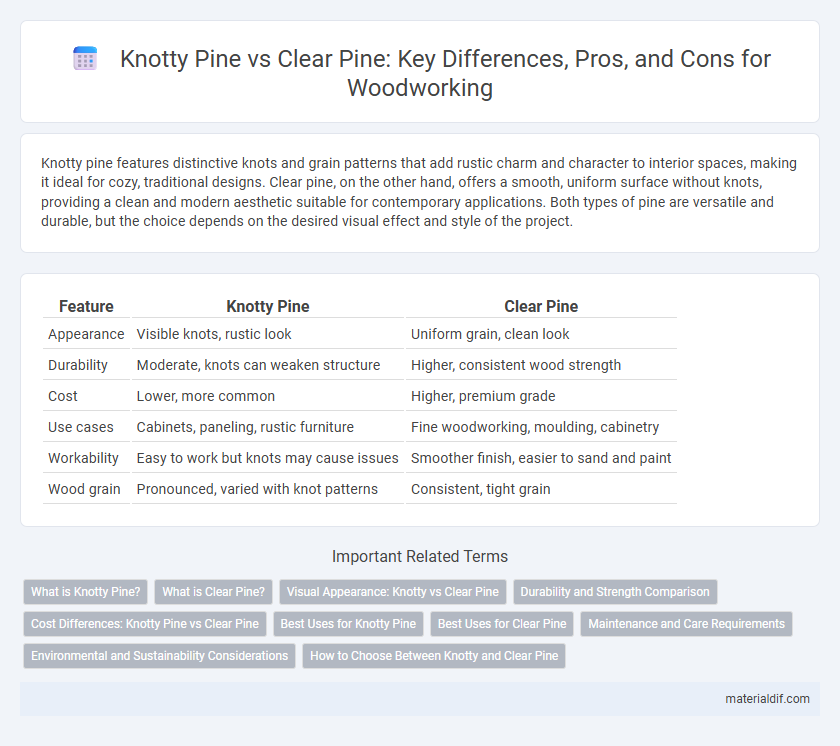Knotty pine features distinctive knots and grain patterns that add rustic charm and character to interior spaces, making it ideal for cozy, traditional designs. Clear pine, on the other hand, offers a smooth, uniform surface without knots, providing a clean and modern aesthetic suitable for contemporary applications. Both types of pine are versatile and durable, but the choice depends on the desired visual effect and style of the project.
Table of Comparison
| Feature | Knotty Pine | Clear Pine |
|---|---|---|
| Appearance | Visible knots, rustic look | Uniform grain, clean look |
| Durability | Moderate, knots can weaken structure | Higher, consistent wood strength |
| Cost | Lower, more common | Higher, premium grade |
| Use cases | Cabinets, paneling, rustic furniture | Fine woodworking, moulding, cabinetry |
| Workability | Easy to work but knots may cause issues | Smoother finish, easier to sand and paint |
| Wood grain | Pronounced, varied with knot patterns | Consistent, tight grain |
What is Knotty Pine?
Knotty pine is a type of softwood characterized by its prominent knots and rustic appearance, commonly used in interior paneling and furniture for a cozy, natural look. Unlike clear pine, which has minimal to no knots and a smooth, uniform grain, knotty pine showcases unique patterns created by the knots, adding visual interest and texture. Its affordability and availability make knotty pine a popular choice for cabins, country-style decor, and DIY woodworking projects.
What is Clear Pine?
Clear pine is a type of pine wood characterized by the absence of knots, providing a smooth and uniform grain that enhances its aesthetic appeal and structural integrity. It is highly sought after for fine woodworking, furniture making, and interior paneling due to its clean appearance and ease of finishing. Clear pine typically comes from the heartwood or carefully selected sections of the tree, ensuring consistent quality and minimal defects.
Visual Appearance: Knotty vs Clear Pine
Knotty pine features a rustic visual appearance characterized by prominent knots and natural imperfections, creating a warm and textured aesthetic ideal for cabins or country-style interiors. Clear pine offers a smoother, cleaner look with minimal knots, highlighting the wood's natural grain and providing a more refined and modern finish. The choice between knotty and clear pine depends on the desired ambiance, with knotty pine emphasizing character and clear pine emphasizing simplicity.
Durability and Strength Comparison
Knotty pine typically contains more natural defects such as knots, which can affect its structural integrity and reduce overall strength compared to clear pine, known for its uniform grain and fewer imperfections. Clear pine offers higher durability and resistance to warping or splitting, making it more suitable for load-bearing applications and fine woodworking projects. While knotty pine provides a rustic aesthetic, its strength limitations make it less ideal for situations requiring consistent durability and stability.
Cost Differences: Knotty Pine vs Clear Pine
Knotty pine generally costs less than clear pine due to the presence of knots, which are considered natural imperfections, reducing the overall grade and value of the wood. Clear pine, free from knots and boasting a uniform appearance, commands a higher price, favored for fine woodworking and cabinetry. Price differences can range from 20% to 40%, depending on quality, sourcing, and market demand.
Best Uses for Knotty Pine
Knotty pine is ideal for rustic cabinetry, paneling, and furniture where a distinctive, natural character with visible knots enhances aesthetic appeal. Its durability suits interior applications such as accent walls and ceiling treatments, particularly in cabins or country-style homes. Compared to clear pine, knotty pine offers a textured, warm look, making it a preferred choice for decorative elements that emphasize wood's organic beauty.
Best Uses for Clear Pine
Clear pine, characterized by its smooth surface and minimal knots, is ideal for furniture making, cabinetry, and interior trim where a clean, polished appearance is essential. Its uniform grain and light color enhance paint adhesion and stain application, making it preferred in high-end millwork and decorative woodworking projects. Clear pine's stability and ease of finishing ensure durability and aesthetic consistency in fine carpentry and architectural details.
Maintenance and Care Requirements
Knotty pine requires more frequent maintenance due to its natural knots and resin pockets, which can attract dirt and are prone to discoloration over time. Clear pine offers easier upkeep with fewer imperfections, allowing for smoother finishes and less frequent cleaning or sealing. Both types benefit from regular dusting and protection from moisture to preserve wood integrity and appearance.
Environmental and Sustainability Considerations
Knotty pine often comes from lower-grade lumber, utilizing wood that might otherwise be discarded, promoting resource efficiency and reducing waste. Clear pine, typically derived from higher-grade timber, requires stricter tree selection, which can lead to increased environmental impact due to fewer usable logs per tree. Choosing knotty pine supports sustainable forestry practices by maximizing wood usage and minimizing the need for additional logging, whereas clear pine may demand more frequent harvesting cycles.
How to Choose Between Knotty and Clear Pine
Choosing between knotty pine and clear pine depends on the desired aesthetic and application; knotty pine features prominent knots that create a rustic, natural look ideal for cabins and casual interiors, while clear pine offers a smooth, clean surface suited for modern, refined spaces. Assess the importance of visual texture and imperfections, as knotty pine's character adds warmth but may require more maintenance due to knots, whereas clear pine provides a uniform finish that is easier to paint or stain. Consider structural needs and budget as knotty pine is often more affordable and readily available, making it a practical choice without compromising durability.
Knotty Pine vs Clear Pine Infographic

 materialdif.com
materialdif.com